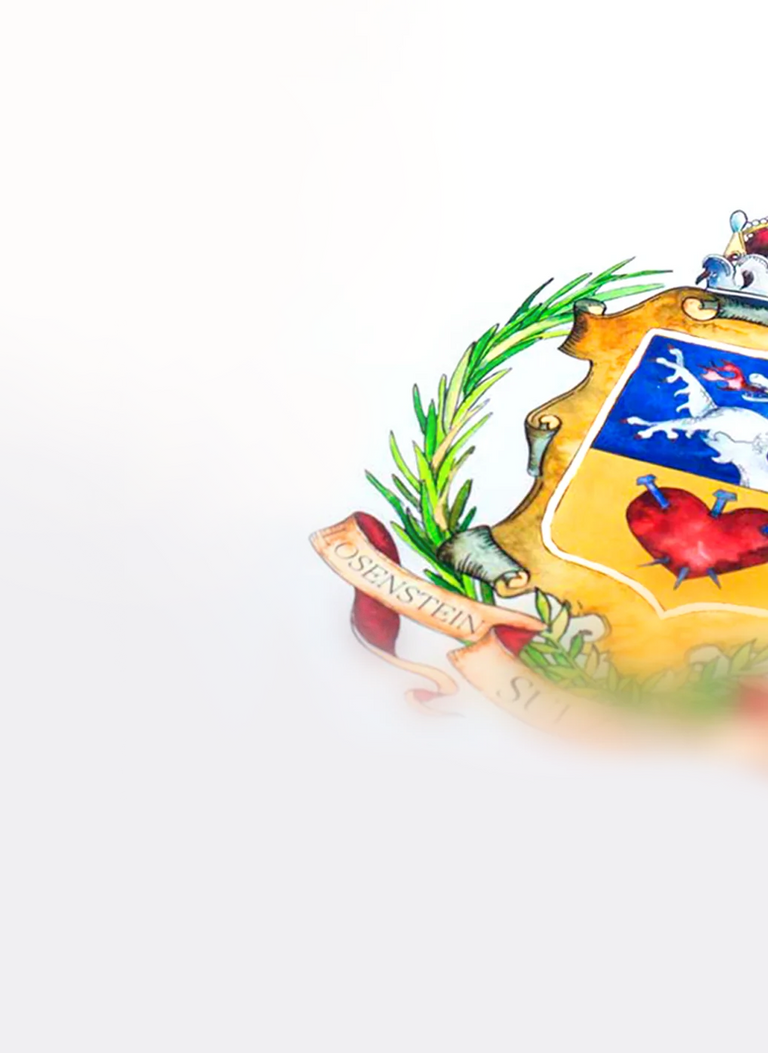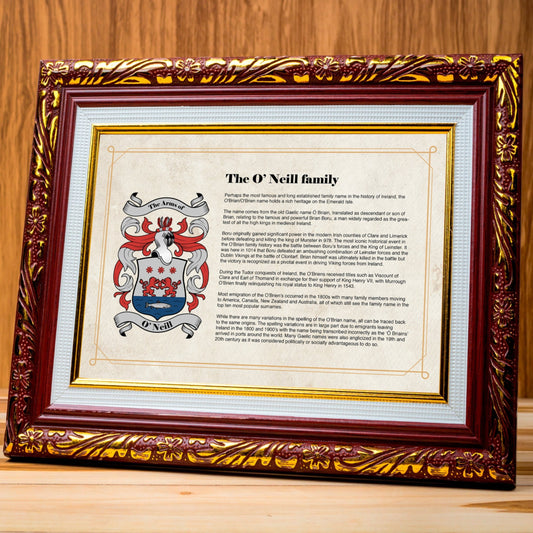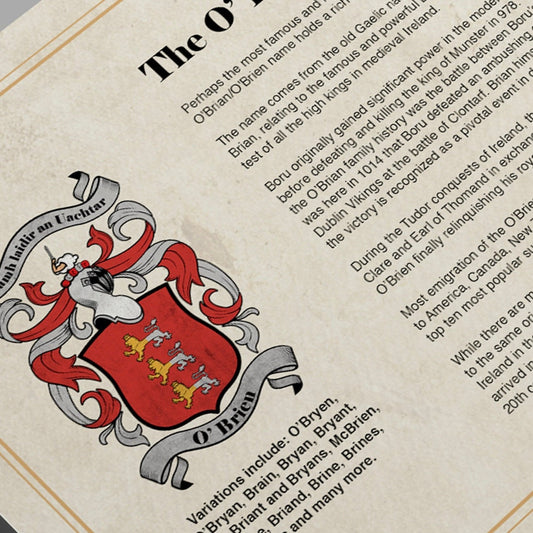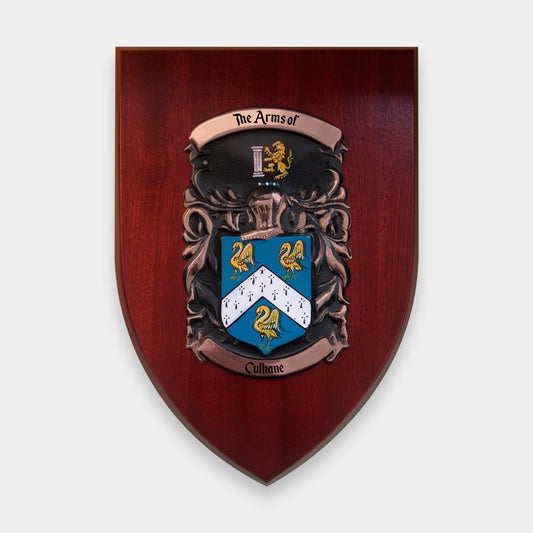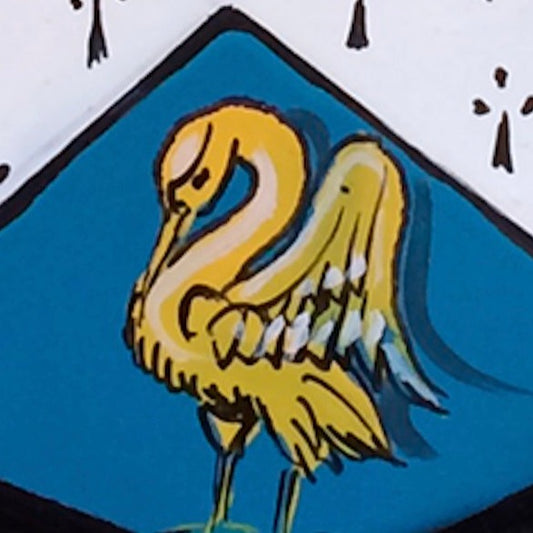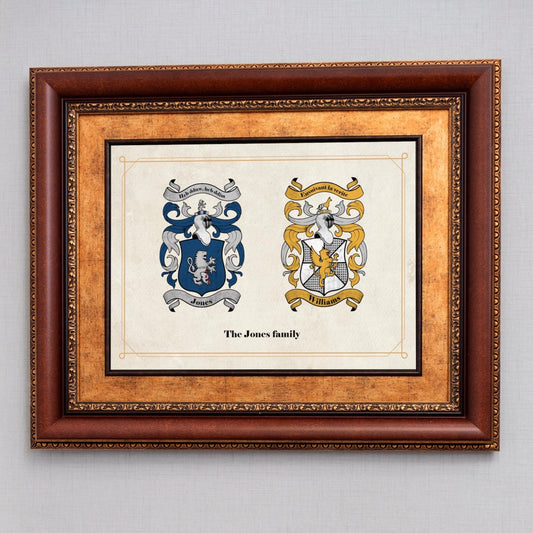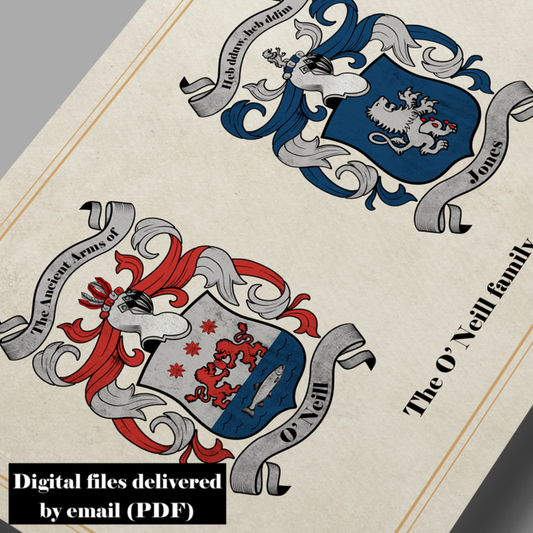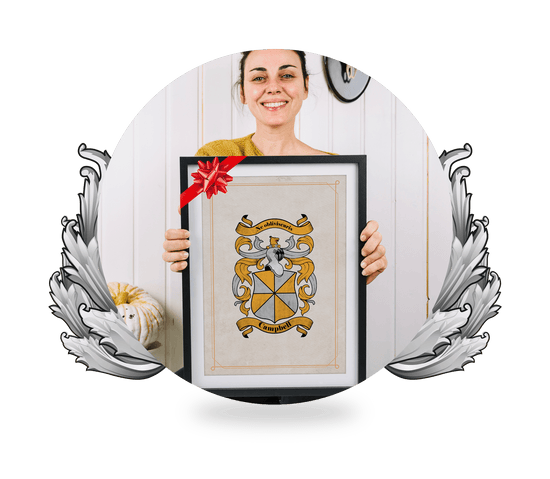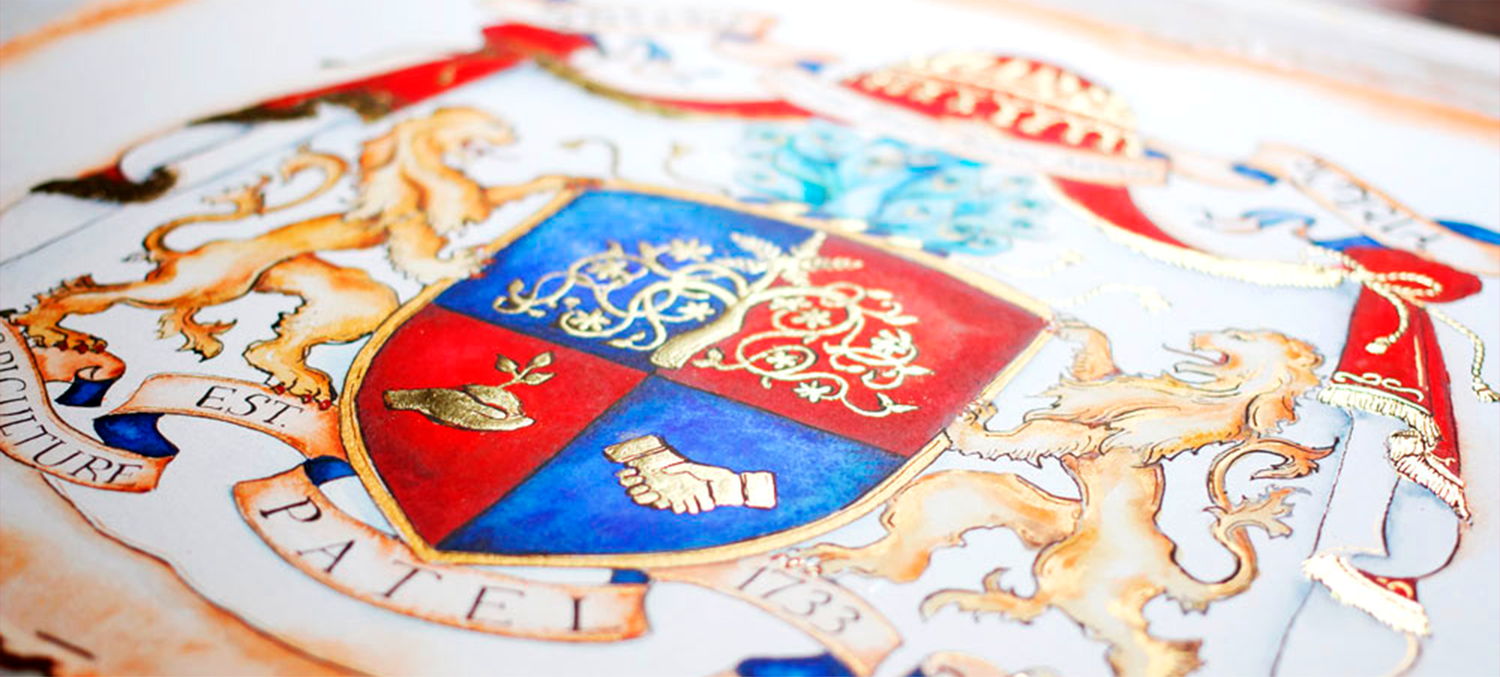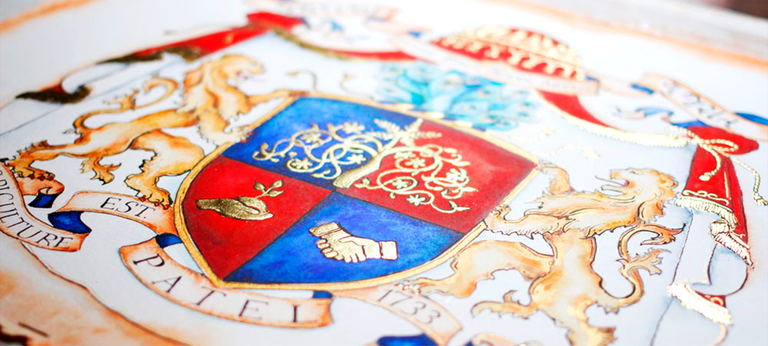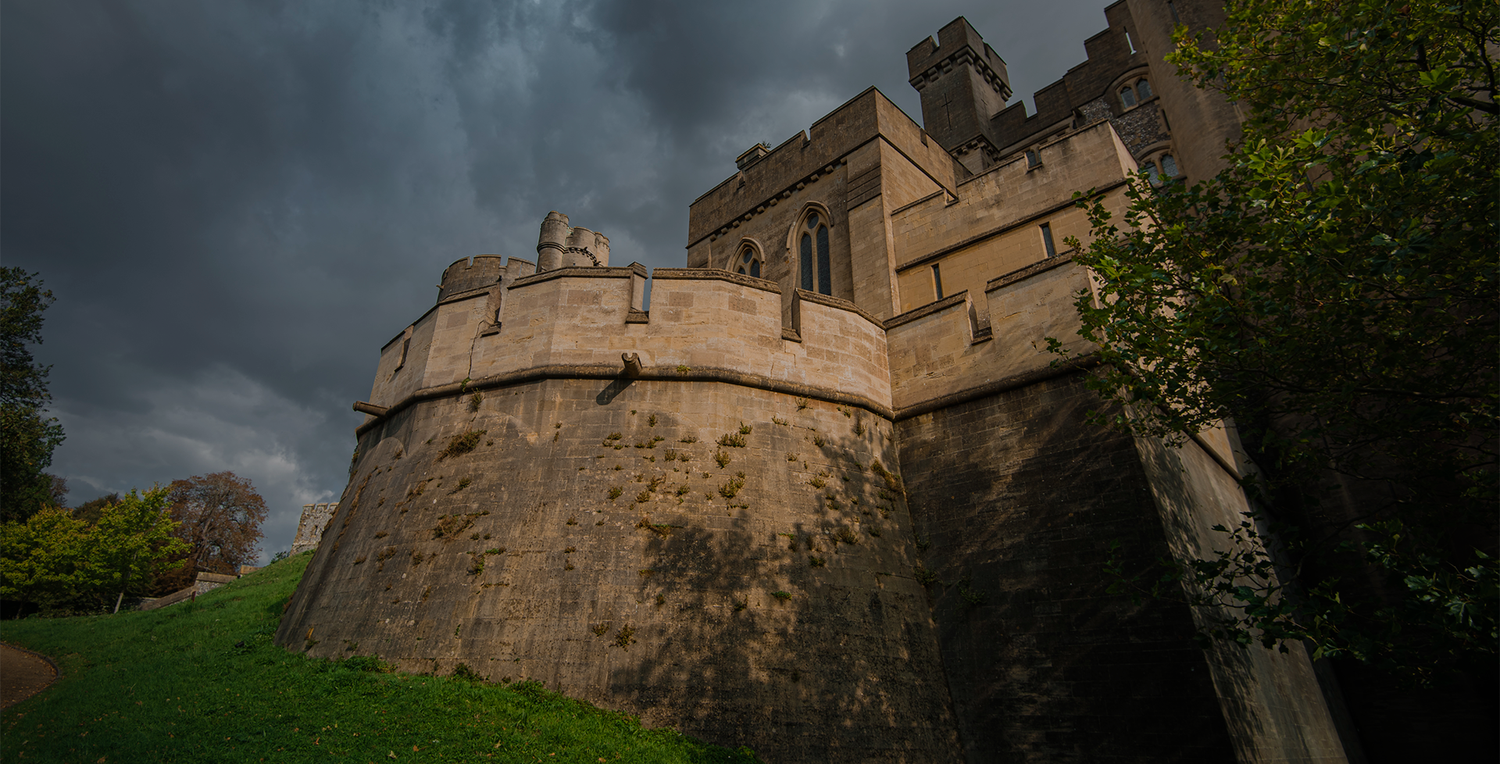How to find your family crest
Click for details
+
Wondering how to find your family crest? Maybe you’ve been struggling to find your coat of arms for a while? Read on…
STEP ONE: Understand where your crest came from.
Every design element that you see on a coat of arms or family crest holds a specific meaning.
The designs were typically granted around the 12th century by governing bodies and monarchs, mostly in Europe.
Coats of arms were originally created to make knights more easily identifiable on the battlefield.
The designs were of particular value when closed face shields came into use on helmets.
Where it was previously possible to identify an ally by looking at their face, knights could suddenly be easily mistaken for one another once in full armour.
Adding an external colorful design to their attire solved this problem, as a fellow knight only had to find your coat of arms instead of recognising your exact armour.
The crests and symbols were added to the coats worn over a knight's metal plates, hence the name, ‘coat of arms’.
The design was also added to their shields and the ‘caparison’ on their horses (a decorative horse jacket).
Why do I see different designs for my coat of arms?
If you’re searching online today to find your family crest, you may have noticed multiple design variations for your name.
As the centuries progressed, coats of arms became a more general symbol to represent a family name or house, and not just something worn on the battlefield. This led to the wider popularisation of coats of arms which means that several versions of a design may exist.
This can happen when family members developed their own versions of the design with slight adjustments over generations or at times could have represented different family groups in different regions.
It could also happen if a family name developed independently in multiple places at once. Which happened quite a lot, especially between France, Ireland, Scotland and England.
This commonly occurred when a family name emerged in different languages but were later combined together into a common name as English became the dominant spoken language of a country. All of which makes it even harder to find your family crest today.
STEP TWO: Understanding armoury records
The only real way to find your family crest is to research what's known as armoury records. These manuscripts and old books contain the original descriptions of each coat of arms, just as they were documented when first created.
Armoury records were needed in the middle ages because family coats of arms were considered so crucial to family members identity there had to be some kind of formal recognition of the design. You can imagine a scenario where a new coat of arms being granted could accidentally copy an existing design, which would have been a big problem for noble families in those times.
Armoury records also allowed officials to find a coat of arms or family crest design when needed in the middle ages, if for example new goods, weaponry or clothing were being made that should feature the design.
To find your family crest, you’ll need to know which country your family name originally came from. You can use a reference like Ancestry.com to help get some of this information.
Once you know where your family name comes from, you can begin researching armoury records from that country to try and find your coat of arms description.
STEP THREE: Find the correct Armoury record
There are hundreds of armoury records out there, but some popular resources include;
- Grantees of Arms to the end of the 17th century
- MacLysaght Irish Families: Their Names, Arms, and Origins
- Burke's Peerage, Baronetage & Knightage (and other Burke’s resources)
- Fairbairn's Book of Crests of the Families of Great Britain and Ireland
- The College of Arms/ Heralds' College Royal College resource
- General armorial of Europe by Rietstap
Since armoury records are very old by nature, you may need to contact publishers directly to track down a copy of a book or manuscript. Others can be found in used book stores and markets. It can take a while but be patient, as finding the correct armoury record is crucial if you’re to find your real coat of arms.
Once you’ve got your hands on a record that relates to the country you need, you can search within their alphabetical listings to find your name.
Be aware that the spelling of your family name most likely changed over the centuries, so you’ll need to look for variations of your name within the armoury records.
This was particularly the case for names that were brought to the United States and Canada. Due to the vast numbers of people immigrating into these countries and the low literacy levels at the time, many names were recorded incorrectly when someone landed at a port for the first time.
This happened simply because family names were spoken out loud to immigration officials after disembarking a ship. Since many names of European origin had unfamiliar spellings to those officials, they simply wrote down the simplest phonetic spelling of the name in the official immigration document. Similar documentation of a name in this way led to it becoming the ‘official’ spelling over time within North America.
For example, the coat of arms for the name Eskey was actually recorded as ‘Esquay’ within ancient armoury records and you would have to search that original spelling to find your coat of arms.
STEP FOUR: Translate the record to English
Armoury records like those listed above were most often written in old English, ancient French and old German, so you’ll need to translate the record to modern English to understand what symbols and colors should be in your family crest.
As well as using a dictionary to translate the basic language, you’ll need a resource such as this to help as a glossary of Heraldic terms. Heraldic words are from a language used to communicate exactly how the design and symbols should be laid out on every coat of arms.
STEP FIVE: Find a designer for your family crest
You may be thinking, “Once I find my family crest, then what?”. Then you just have to get someone to design it for you.
You can search online using websites like 99designs to find a designer who can recreate the design based on your new translated description. A good designer typically costs between $30-$50 per hour of work.
If you’ve done a good job of translating your coat of arms description, an experienced designer should be able to create the design in two hours of work.
Don’t have time to find your family crest yourself or struggling to find your coat of arms? Let our team do the work for you. Our products include all professional research on your behalf and also includes all design work by our professional artists. Shop now to learn more.
What is a family crest
Click for details
+
In the ancient echoes of time, amidst the clash of steel and the grandeur of royal courts, a visual language unfolded.
A language bearing the identity, honor, and lineage of those who came before us, an ornate symbolism of our ancestral heritage — the Family Crest.
Akin to a time machine, these crests journey us back to the medieval era, a period filled with tales of knights, nobles, chivalry, and profound lineage.
Venture with us, if you will, back to the age of heraldry, a time when the family crest was not just an emblem but a personification of a family's honor and pride.
Family crests, or coats of arms, took root in Europe during the High Middle Ages, a time when knights clad in heavy armor would ride into the battlefield, their identities concealed.
The shield bore the responsibility of not only protecting these warriors but also distinguishing them. The heraldic design upon a knight's shield was the sole identifier amidst the chaos of war.
It whispered tales of the knight's lineage, prowess, and courage to both friend and foe.
These crests, however, went far beyond mere battlefield identifiers.
They marked seals on legal documents, engraved on the monumental architecture, and embroidered on the grand tapestries. They were an integral aspect of medieval social structure, a silent testament to one's lineage and societal status.
Crafting a family crest was no frivolous task. It was the art of heraldry, a unique blend of design and symbolism that manifested into a family's unique emblem.
Every color, pattern, figure, and beast held a distinct meaning.
Lines could be zig-zagged to signify water or straight for the earth.
Noble creatures such as lions and eagles portrayed courage and strength, while mythical beasts like unicorns and griffins added an element of mystery and magic.
The arrangement of these elements was not random but a thoughtfully crafted pattern narrating a family's history, achievements, and aspirations.
The crest, hence, was more than a mere emblem; it was a riddle coded in symbols, a cryptic narrative waiting to be deciphered, and a time capsule that preserved the essence of generations gone by.
It held the potential to narrate the rise of a humble squire to a noble knight or the diplomatic acumen of a family securing the King's favor.
They could paint a canvas of bravery, ambition, betrayal, or even redemption.
Despite being firmly rooted in the past, family crests endure and continue to captivate our imaginations. They stir a sense of curiosity and awe as they hold within them the power to transport us back to the glorious days of yore, allowing us a peek into the lives of our ancestors.
Family crests are far more than heraldic artistry of old; they are a bridge that connects us to our heritage.
They remind us that we are but the latest links in an ancient chain, carrying forward a legacy etched in the annals of time.
The family crest symbolizes our roots, telling us that we are a part of a story that began long before us and will continue long after we are gone.
So, the next time you gaze upon a family crest, pause for a moment. Let its intricate symbolism take you on a voyage back to a time of knights and nobles, of honor and heraldry.
Feel the echoes of history and the legacy of generations pulsating through the crest.
For it is not just a symbol; it's a saga, a tale of heritage, lineage, and the indomitable spirit of our
Do you provide an official family crest?
Click for details
+
Rest assured, we only use official historical documents, first-hand research and society records to re-create your official family crest. As members of multiple heraldry societies and collectors of unique coats of arms records, our team has access to the resources needed to accurately bring any crest back to life, with the same detailed symbolism as when it was first created.
Our process starts when you purchase a coat of arms. Our researcher will begin by searching your family name in our collection of armoury records, many of which date as far back as the 1100s.
These records span many countries in Europe where coats of arms were most often granted in medieval and middle ages, and in total cover hundreds of thousands of family names.
At times, your family name may have been originally recorded with a slight spelling variation, since the exact spelling may have changed in the centuries since the family crest was first recorded. Rest assured, our team knows how to trace such finer points and will do so as part of the base cost of your coat of arms purchase.
Once a record has been identified, our researcher will translate it into modern English. This is essential since most coats of arms were recorded in ancient English, French, German or a combination of all three.
Once translated, our researcher works with our heraldic artist to recreate your family coat of arms exactly as it was documented in its official armoury record, meaning the symbols, colors and layout will be precisely as it was centuries ago, just as your family name ancestors would have seen it.
What makes your family crests unique?
Click for details
+
Our team has almost 3 decades of combined experience in coat of arms research and design. We know how to recreate original crests and coat of arms from official documents and research notes to an exacting standard unmatched by competitors.
Almost all other competitors that you will find online will provide a coat of arms product that is premade and delivered to you automatically after you purchase. This makes it difficult to be sure you’re getting a family coat of arms that genuinely applies to your name.
Our team operates differently. We research every family crest when a customer places an order, using official armoury records. This means a researcher will review every order placed and work with our artists to recreate your crest to an exact specification. So you can rest assured that your coat of arms will be one that has a genuine and traceable connection to your family name.
We only use the highest standard materials in our physical prints to ensure your print shines with the kind of love and quality that your family crest and name deserves.
Luxury aged parchments and ultra sharp non-fading inks are our standard and we won't use anything less.
For more details about our products and team, please read our story.
How long do family crest orders take?
Click for details
+
Depending on the time of year and what you order, our team can research and deliver your family crest in as little as 24 hours. Even when things are busy, we still dispatch 90%+ of orders within 48 hours (Mon-Fri). If you have a special request or question about your crest, please contact us. For details on shipping times, please refer to our delivery and shipping section at the bottom of each product page. Shipping is free on all products on our website.
What is heraldry?
Click for details
+
Heraldry is the process of creating, displaying and granting use of coats of arms and family crests along with the detailed methods by which family histories and crests are traced and brought back to life.
Heraldry is closely related to genealogy with many of the same skills employed by heraldry researchers. The key difference is that heraldic artists and experts also possess a deep knowledge of ancient armours and armorial symbolism.
Heraldry became estblished in many European countries such as England in the early 1100s. It began as knights first introduced helmets with face shields that made it difficult to recognise a specific person within armour. To solve this problem, knights began to add designs, symbols and illustrations to the outside of their armour, to make them more easy to recognise. Over time, these designs became what are known as coats of arms. Family crests became established when a knight or person of nobility used the same design over time.
Not long later, coats of arms became something that were granted to a family member and registered in order to keep track of who 'owned' and used each specific design. As the centuries passed, other family members of the same name often began to use the design as a means of identity.
As more people were granted coats of arms, it became increasingly important to keep track of them.
The more crests that came into existence, the more important it became to differentiate the designs with specific colors and symbols such as animals, weapons and other elements.
Each color and symbol then took on a specific meaning and told the earliest story of the achievements and values of the family to which it belonged.
There were even specific rules about how and when each symbol could be used and how they should be arranged on a coat of arms.
These 'rules' and the knowledge of how to interpret the meaning of the symbols is what heraldry is all about.
Whats the difference between coat of arms and family crest?
Click for details
+
In the hallowed halls of time, where echoes of ancient power and prestige linger, there exists a striking and intricate world of symbols and colors.
This world, called Heraldry, bore the responsibility of distinguishing one noble family from another, weaving tales of their lineage, their history, and their honor.
Two key elements within this symbolic language, often used interchangeably yet uniquely distinct, are the Coat of Arms and the Family Crest.
Journey with us back to medieval Europe, an era brimming with chivalry, knightly honor, and intricate symbolism, as we unravel the subtle yet significant differences between these two heraldic symbols.
The Coat of Arms, in essence, was a knight's personal brand. Introduced in the 12th century, it was a distinct design painted onto the shield of a knight, acting as his unique identifier on the battlefield, where his face was often obscured by his helmet. It was more than just a mere form of identification; it was a representation of the knight's valor, lineage, and deeds. Every hue, figure, line, and symbol were meticulously chosen to reflect his family's history, honor, and societal stature.
An entire coat of arms is referred to as an "achievement," and it is composed of several elements.
The shield, or escutcheon, is the most prominent and carries the primary heraldic design. It is often surrounded by other elements such as supporters, motto, helm, and the often misunderstood crest.
And here, we venture into the heart of our quest - the Family Crest.
Contrary to common understanding, the crest was not historically synonymous with the coat of arms (even though today the terms are used interchangeably) but is, in fact, a component of it.
It adorns the top of a helm, like a crowning glory, and is typically depicted as a three-dimensional object, such as a lion, a tower, a hand, or any such symbol that holds significant meaning to the family.
In the clamor of battle, amidst the whirl of dust and steel, the family crest stood aloft, marking the presence of its bearer.
When knights would lower their visors, the crest would become their beacon, their symbol rising above the sea of helmets. Beyond warfare, it often found its way onto wax seals and signet rings, imprinting its legacy on legal documents and correspondences, marking them with the authority of its bearer.
The confusion between the two terms often arises from a blend of history and linguistic evolution.
In contemporary times, the term 'family crest' has colloquially been used to denote the entire coat of arms, not just the crest component. Yet, the subtle distinction remains, preserved by the purists of heraldry.
Delving into the world of heraldry and understanding the nuances between a coat of arms and a family crest is akin to embarking on a captivating journey into our ancestral heritage.
These symbols, steeped in history and veiled in the mystery of ages past, transport us back to a time where chivalry reigned supreme and honor was symbolized in vivid colors and intricate designs.
So, the next time you marvel at the grandeur of a family crest or admire the storytelling etched onto a coat of arms, remember, you are not merely looking at symbols. You are peering into the soul of history, you are beholding a family's honor, legacy, and lineage, meticulously crafted and carefully preserved in the timeless language of heraldry. Indeed, these are more than just symbols; they are vivid chapters from the grand book of yore, narrating tales of times past and carrying them forward into the annals of future history.
Do you offer discounts for bulk crest orders?
Click for details
+
Yes, we offer discounts for family crest bulk orders and coats of arms business orders where 10 or more units are desired. For more info on discounts and bulk orders, please reach out to our team via our contact page.










